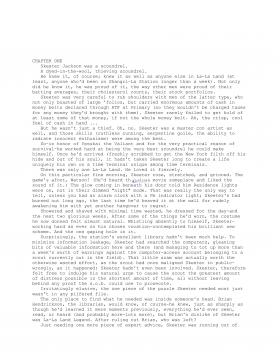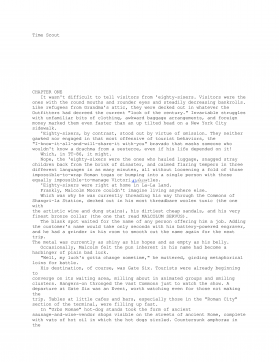file:///F|/rah/Julian%20May/May,%20Julian%20-%20Pliocene%20Exile%201%20-%20The%20Many%20Coloured%20Land.txt
of vegetation along the narrow lip and down the steep slope to the water.
About twenty meters away from her stood a terrible bird. It was something like a fat heron but as
tall as a pine tree and just as long, with wings, head, and tail drooping sadly to the ground.
From its belly trailed a knobbly appendage with climbing holds. The bird was hard, not made of
flesh. It was layered in dust, crusted and scabbed with yellow and gray and orange lichen over
what had once been a smooth black skin. Far along the rim of the astrobleme, in both directions,
she could see other such birds standing widely spaced, all looking into the dark-mirrored depths.
The ramapithecus prepared to flee. Then she heard a familiar sound.
She gave a sharp hoot. Immediately, a tiny upside-down head popped out of an orifice in the belly
of the nearby bird. The child chittered happily. His sounds had the meaning: "Wet come, Mother.
This is fun! Look what is here!"
Exhausted, overcome by relief, her hands bloody from breaking through the thorns, the mother
howled in fury at her offspring. Hastily, he came down the exit ladder of the flyer and scuttled
up to her. She scooped him up and crushed him to her breast, then she put him down and cuffed the
sides of his head, left-right, pouring out a torrent of indignant chatter.
Trying to placate her, he held out the thing he had found. It resembled a large ring, but was
really two conjoined semi-circlets of twisted gold, thick as a finger and rounded, incised with
tortuous little markings like the borings of gribbles in sea-logged wood.
The young ramapithecus grinned and snapped open two knobby ends of the ring. The other ends were
held by a kind of pivoting hinge that allowed the halves to rotate and open wide. The child placed
the ring around his neck, twisted it and snapped the catch shut. The golden torc gleamed against
his tawny fur, much too large for him but alive with power nevertheless. Smiling still, he showed
his mother what he was now able to do. She shrieked.
The child leaped in dismay. He tripped over a rock and fell backward. Before he could recover, his
mother was upon him, yanking the ring over his head so that the metal bruised his ears. And it
hurt! The loss of it hurt worse than any pain he had ever known. He must get it back.
The mother screamed even louder as he tried to grab at the tore. Her voice echoed across the
crater lake. She flung the golden thing as far away as she could, into a dense thicket of spiny
gorse. The child wailed his broken-hearted protest, but she seized his arm and hauled him toward
the path she had made through the maquis.
Well concealed and only slightly dented, the torc gleamed in the dappled shadows.
CHAPTER THREE
In the early years after humanity, with a little help from its friends, had set out to overrun the
compatible stars, a professor of dynamic field-physics named Theo Guderian discovered the way into
Exile. His researches, like those of so many other unorthodox but promising thinkers of the time,
were sustained by a no-strings grant from the Human Polity of the Galactic Milieu.
Guderian lived on the Old World. Because science had so many other things to assimilate in those
exciting times (and because Guderian's discovery seemed to have no practical application
whatsoever in 2034), the publication of his culminating paper caused only a brief flutter in the
dovecote of physical cosmology. But in spite of the prevailing air of indifference, a small number
of workers from all six of the coadunate galactic races continued to be curious enough about
Guderian's findings to seek him out in his modest home-cum-workshop outside of Lyon. Even as his
health failed, the Professor received these visiting colleagues with courtesy and assured them
that he would be honored to repeat his experiment for them if they would pardon the crudities of
his apparatus, which he had removed to the cellar of his cottage after the Institute disclaimed
further interest in it.
It took Madame Guderian some time to become resigned to the exotic pilgrims from other stars. One
had, after all, to preserve the social convenances by entertaining the guests. But there were
difficulties! She overcame her aversion to the tall, androgynous Gi after much mental exercise,
and one could always pretend that the Poltroyans were civilized gnomes. But she could never get
used to the awesome Krondaku or the half-visible Lylmik, and one could only deplore the way that
some of the less fastidious Simbiari dripped green on the carpet.
What was to be the last group of guests called just three days before Professor Guderian's
terminal illness commenced. Madame opened the door to greet two outworld male humans (one
alarmingly massive and the other quite ordinary), an urbane little Poltroyan wearing the gorgeous
robes of a Full Elucidator, a two-and-a-half-meter Gi (mercifully with clothes on), and, Sainte
Viergel, no less than three Simbiari.
She welcomed them and put out extra ashtrays and waste-baskets.
Professor Guderian conducted the extraterrestrial visitors to the cellar of the large country
cottage just as soon as the politenesses had been exchanged. "We will proceed at once to the
file:///F|/rah/Julian%20May/May,%20Julian%20-...le%201%20-%20The%20Many%20Coloured%20Land.txt (3 of 165) [1/15/03 7:40:30 PM]

 2024-12-08 12
2024-12-08 12
 2024-12-08 14
2024-12-08 14
 2024-12-08 10
2024-12-08 10
 2024-12-08 10
2024-12-08 10
 2024-12-08 15
2024-12-08 15
 2024-12-08 18
2024-12-08 18
 2024-12-08 27
2024-12-08 27
 2024-12-08 25
2024-12-08 25
 2024-12-08 16
2024-12-08 16
 2024-12-08 30
2024-12-08 30








 渝公网安备50010702506394
渝公网安备50010702506394
